- Home
- Beginners Watercolor
Start Painting Watercolor for Beginners, It's Easy
You can confidently learn how to paint watercolor for beginners!
This tutorial explains step-by-step how to paint a watercolor Rufous Hummingbird feeding from a colorful flower.
Watercolor is a clean, convenient paint we can use to create any picture we can imagine.
 Learning about watercolors
Learning about watercolors Learning about watercolors
Learning about watercolorsWatercolor for Beginners
Discover the joy and ease of watercolor painting.
This page covers 7 basics for the beginning watercolor artist:
Start with the Basics
We do not have to mix or add anything to the paint - just water.
How do we adjust the colors?
- Light colors: Add more water to the color.
- Intense colors: Use less water with more paint.
What Supplies Will We Use?
This tutorial is on an 8x10 Aquabord panel. It certainly may be painted on 140# watercolor paper.
Use a round #7 brush for the hummingbird and a flat brush for the background.
 Split Compliment color scheme
Split Compliment color schemeThis painting uses a split compliment color scheme of only 3 colors.
- Use any blue of your choice, I used Ultramarine Blue.
- An orange like Quinacridone Sienna or Burnt Sienna
- Any yellow like; Lemon Yellow, Cadmium Yellow or New Gamboge
Using a limited number of colors automatically creates color harmony.
Sketch and Transfer the Design
Sketch out the hummingbird. Then transfer the drawing to your painting surface with graphite paper.
People good at drawing can draw the hummer directly on the painting surface. But be aware that erasures can damage watercolor paper.
Use Clean Water and Pure Colors
The water and colors are the joy of painting watercolor.
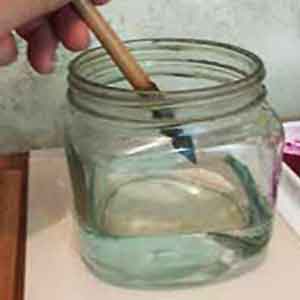 Keep your colors clean!
Keep your colors clean!Keep a container of clean water handy for painting and washing the brushes.
- Dip the brush into clean water and then into a color.
- Mix the colors on a palette, not in the wells of color, so the colors remain clean.
- Clean the brush with water between colors.
- When the water gets dirty, get fresh water.
Blot the excess water out of the clean brush on a paper towel, rag or sponge kept next to the water container.
Paint Wet into Wet
It's great to read about painting watercolor, but let's start the hummingbird.
We start with the basic technique for beginners, painting wet into wet.
Paint the Hummingbird's Throat
Using the round watercolor brush, prewet the throat area.
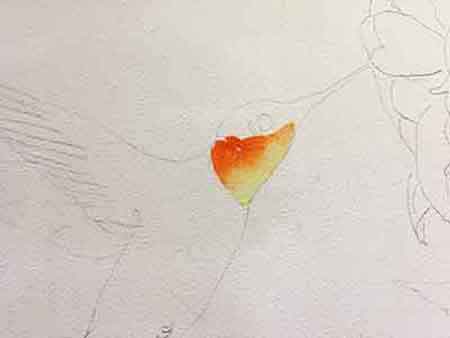 Paint the throat
Paint the throatBriefly let the water soak away to an even a sheen.
The light source in this painting is from the right.
- Paint a pale yellow on the side toward the light.
- While the yellow is still wet, put orange on the opposite side.
- Allow the two colors to mingle together.
Watching the beautiful colors flowing together is one of the joys of painting watercolor.
Painting the Hummingbird's Body
Painting wet into wet allows the paint to spread into the wet areas.
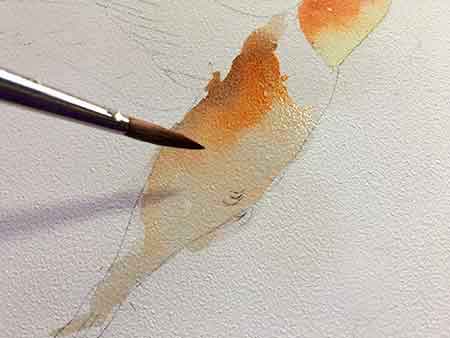 Paint the hummingbird's body.
Paint the hummingbird's body.Wet the body with clean water from your brush.
Do not wet the white throat area.
Mix blue and orange to make brown. Add plenty of water for a light brown.
- Paint the belly light brown.
- As we paint up, add more orange to the mixture.
- At the top or the body use a darker brown.
Leave the area between the throat and body
white. The paint will not flow into the dry area.
Painting the Hummingbird's Wings
We will adjust the brown mixture from the body to make a light grey-brown.
 Painting the wings
Painting the wingsAdd blue to the brown mixture to make it grey.
Use plenty of water to make it a light color.
- Paint the forward wing. Just paint over the pencil lines of the individual feathers.
- Colors get lighter and cooler, as they go into the distance.
- So, the wing behind will be lighter and a tiny bit cooler to set it back.
Add a tiny bit of blue and more water. That makes the wing look farther away.
Using the White Paper
Leaving the white paper is another great watercolor technique for beginners.
Paint the Hummingbird's Head
We left the throat of the hummingbird white. Now we will leave white on his head.
 Paint the head with stippling strokes.
Paint the head with stippling strokes.Mix blue with orange to get a warm orange-brown for the top of the head.
Paint the top of the head by touching with the tip of the brush.
- This leaves stippling marks to simulate the short feathers.
- Leave the eye, around and behind the eye white.
We use the white of the paper instead of using white paint.
Get more information about saving and using the white watercolor paper.
Paint Wet on Dry
Painting wet on dry is part of watercolor for beginners.
Use this technique where we want defined, sharp edges.
Painting the Eye, Beak and Feet
We do not prewet the paper before painting. The applied paint will not move onto dry paper.
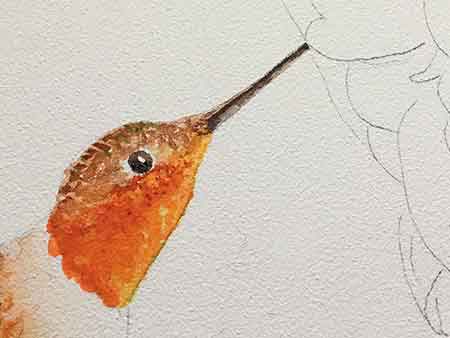 Mix a dark color for the eye, beak and feet.
Mix a dark color for the eye, beak and feet.Add more blue and less water to your blue and orange mixture to make a black.
- Paint the eye leaving a white highlight.
- Leave the white spot behind the eye.
- Paint the beak with one dark line down the center.
Then gently put lighter color on the edges of the beak that catch the light.
Paint the little dark feet with the same mixture.
Gradating the Colors
This is a great watercolor technique for beginners to master. Instead of mixing a dark, medium and a light version of the same color - there's an easier way.
Painting the Flower Petals
Freely paint the flower petals with a variety of orange and yellows.
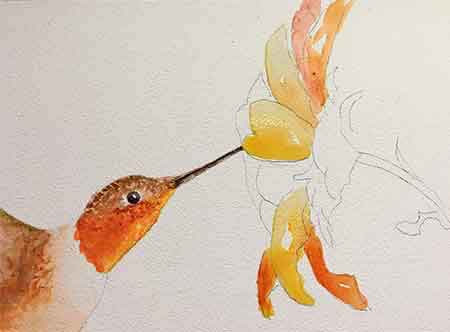 Paint the flower petals.
Paint the flower petals.Contrast some of the yellow petals against darker yellow or orange petals.
- On some petals, put paint on one end of the petal.
- Rinse the brush and use the damp brush to pull the color toward the other end of the petal.
- This makes the color gradate from full color to medium and then to lighter color.
It adds more variety to our artwork. I also enjoy leaving some white spaces for a little spark.
#1 Rule in Painting Watercolor
Painting light to dark is the #1 basic rule of painting watercolor.
The dark colors cover lighter colors when we paint over them. But it won't work the other way around. Light watercolors with not cover the darker colors.
Painting the Green Flower Parts
Mix a variety of greens from your blue and yellow.
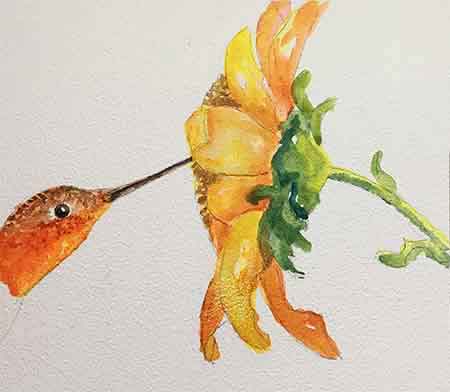 Paint the green sepals and stem.
Paint the green sepals and stem.Add more yellow for the green toward the light.
Additional blue makes a darker green for the underside of the stem and other areas away from the light.
- Paint the yellow-green first.
- Then paint the darker green areas.
- The dark green covers the light colors we paint over.
Paint the flower centers by stippling on a variety of brown and yellow.
Light versus dark values are an important fundamental of painting.
Painting a Wash
A wash is normally done wet on wet on a large area like the sky, a large lake, etc.
You would prewet the area and start with a dark color. Add water as you paint down the paper, so the color gets lighter and lighter.
It may be done in reverse. Start with a light color. As you paint add more paint to darken color or even change colors.
Painting the Background
This painting has three small background areas, so it's not the best place to paint a wash. But it is a good place to practice, so give it a try.
 Paint the background.
Paint the background.Use a flat brush to dampen and paint one area at a time.
The damp paper prevents a hard edge from forming while we paint.
- Smoothly apply the color.
- You may make some marks behind the bird to simulate flight movement.
- Pull the marks out with a clean, damp brush to take off some of the blue paint.
Note: It works the best to not prewet up to the edge of the bird or flower.
Extra water next to them makes the color pool up against their dry edges.
Paint up to their edges while painting on the background color.
There is a good example of painting a background wash in this tutorial.
Watercolor is Fun!
You have completed a watercolor hummingbird painting.
 Painting watercolor is fun!
Painting watercolor is fun!Go over the hummingbird again and darken and brighten any colors where you think it needs it.
You may add a soft color to the wings and add a few lines to indicate separate feathers.
Keep the far wing a subdued color to set it behind.
Do any needed adjustment on the flower petals.
Where a petal is overlapped by a petal next-door, darken the petal behind.
This makes one petal look behind another petal.
Turn Watercolor Mistakes into Opportunities
There are no mistakes that can't be fixed.
Sometimes the highlight on the eye gets accidentally painted. After the paint is dry, you can pick out the highlight with the point of a sharp knife.
We may want to adjust a painted area.
If we make a mistake, use a damp brush to put some water on the mistake. Rub it a bit with a brush and blot the loose color off with a paper towel. Repeat as necessary.
Watercolor for beginners is easy.
Watercolor Clean-up is Easy
Clean the palette with a spray of water in the mixing area. Wipe the loosened colors off with a paper towel.
Wash your brushes by swirling them in a container of clean water. Check to see if all the paint is gone by tapping them on a towel.
Round brushes: Swirl the clean brush in water again and then shake it to make the bristles form a point.
Flat brushes: Caress the bristles with a towel to pull them into a chiseled edge.
Lay the brushes horizontal to dry. Storing a wet brush upright will let stuff run down into the ferrule and eventually ruin the brush.
Clean the water container so you're ready for the next painting.
Jump in and Go for It!
The beauty of watercolor lies in the unique
expression it allows. Experiment and let your creativity flow from your heart.




 Are you eager to learn how to oil paint? What are the essential supplies for oil painting? What do we need for clean-up and how long do oil paintings take to dry? Learn the rules of oil painting and t…
Are you eager to learn how to oil paint? What are the essential supplies for oil painting? What do we need for clean-up and how long do oil paintings take to dry? Learn the rules of oil painting and t…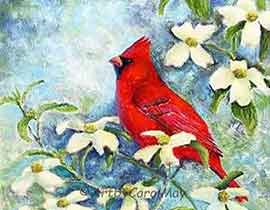 How do we create a focal point in art? Where do we put the focal point? How do we find the focus of an artwork? Should all paintings have a center of interest or can they have more than one? Learn fro…
How do we create a focal point in art? Where do we put the focal point? How do we find the focus of an artwork? Should all paintings have a center of interest or can they have more than one? Learn fro…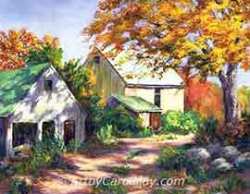 Art elements and principles appear over and over in good paintings. The elements and principles work together for us to create successful artwork. Art principles are the rules that govern how an artis…
Art elements and principles appear over and over in good paintings. The elements and principles work together for us to create successful artwork. Art principles are the rules that govern how an artis…